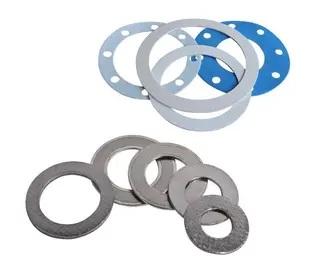Comprehensive Guide to Gasket Selection and Sealing in Industrial Applications

Comprehensive Guide to Gasket Selection and Sealing in Industrial Applications
Gaskets are critical components in industrial systems, whether for pressure vessels, process equipment, power machinery, or connecting pipelines. Their primary function is to prevent liquid or gas leakage. As industrial processes increasingly operate at higher temperatures, pressures, and speeds, the risk of leakage rises correspondingly. Leakage can lead to production interruptions, economic losses, and, in severe cases, fires, explosions, environmental pollution, and even casualties. Therefore, selecting the correct gasket is essential for ensuring safety, efficiency, and reliable operation.
Basic Principle of Gasket Sealing
A gasket is a material—or combination of materials—placed between two connecting surfaces, usually flanges, to maintain a seal over its service life. It must prevent the sealed medium from leaking or causing corrosion while withstanding the effects of temperature and pressure. A gasket sealing system consists of the connecting parts (flanges), the gasket itself, and fasteners such as bolts and nuts. Evaluating sealing performance requires considering the entire flange connection as a system rather than just the gasket alone.
Key Factors in Gasket Selection
Selecting the right gasket requires careful consideration of multiple factors beyond basic parameters like temperature, medium, and pressure. The type of flange, gasket material, thickness, and operating conditions all influence gasket performance.
1. Temperature
The gasket must withstand the system's maximum and minimum operating temperatures. Continuous operating temperature limits and short-term peak temperatures should be considered when selecting materials. For systems near the upper limit of a material’s rating, a higher-grade gasket is recommended.
2. Medium
The gasket must resist the effects of the sealed medium, including oxidation, chemical corrosion, solvents, and permeability. Material compatibility with the medium is critical. Non-metallic materials should be checked against chemical resistance charts, while metallic components should have corrosion resistance at least equal to that of the flanges.
3. Pressure
The gasket must endure the maximum system pressure, often including test pressures 1.25–1.5 times the normal operating pressure. For non-metallic gaskets, pressure limits are also temperature-dependent, with a PxT value that should not be exceeded.
4. Flange Information
Flange material, sealing face type, surface roughness, and bolt specifications must be considered. Different flange types require different gasket types:
-
Raised Face (RF) – Spiral wound with inner and outer rings.
-
Tongue and Groove (TG) – Basic spiral wound type.
-
Male and Female (MFM) – Spiral wound with inner ring only.
5. Gasket Thickness
Thinner gaskets are generally preferable, as they resist stress relaxation better, reduce leakage paths, withstand blowout forces more effectively, and ensure stronger sealing under pressure.
Common Types of Gaskets and Their Characteristics
1. Flexible Graphite Gaskets
Excellent high-temperature resistance and chemical corrosion resistance. Thin, durable, and suitable for high-pressure and high-temperature applications.
2. PTFE Gaskets
Chemically inert with good impermeability. Suitable for medium- and low-temperature applications but limited in high-temperature scenarios.
3. Rubber Gaskets
Elastic and compressible, adaptable to flange unevenness. Suitable for low-temperature, low-pressure, and weakly corrosive environments.
4. Non-Asbestos Fiber Gaskets
Environmentally friendly alternative to asbestos, with good chemical resistance and impermeability. Suitable for a wide range of media.
5. Spiral Wound Gaskets
Alternating layers of metal and non-metallic filler. Good elasticity and sealing performance, adaptable to flange irregularities. Types include inner and outer ring, basic, and inner ring only.
6. Metal Composite Gaskets
Combine metal strength with non-metallic sealing performance. Excellent for high-pressure, high-temperature, and corrosive environments. Types include corrugated, oval, and octagonal gaskets.
Steps for Gasket Selection
1. Determine Operating Parameters
-
Temperature, medium properties, pressure, and flange information.
2. Select Gasket Material
-
High-temperature/high-pressure: metal composite or metal gaskets.
-
Medium-/low-pressure: soft non-metallic or spiral wound gaskets.
3. Select Gasket Type
-
Match to flange type and sealing surface requirements.
4. Determine Gasket Thickness
-
Optimize thickness for stress resistance, blowout resistance, and flange surface conditions.
5. Consider Other Factors
-
Bolt preload calculations, system stability, maintenance procedures, and cleaning fluid compatibility.
Conclusion
Gasket sealing is a cornerstone of safe and efficient industrial operation. Correct selection and installation ensure continuity of production, property safety, energy efficiency, environmental protection, and personnel health. By considering temperature, medium, pressure, flange characteristics, material properties, and proper installation, industrial operators can achieve optimal sealing performance. A well-chosen and properly installed gasket protects both equipment and personnel, contributing to safe and reliable industrial processes.
It's important to know about Google SEO to help your website rank higher in search results.
- Art
- Causes
- Crafts
- Dance
- Drinks
- Film
- Fitness
- Food
- Giochi
- Gardening
- Health
- Home
- Literature
- Music
- Networking
- Altre informazioni
- Party
- Religion
- Shopping
- Sports
- Theater
- Wellness
